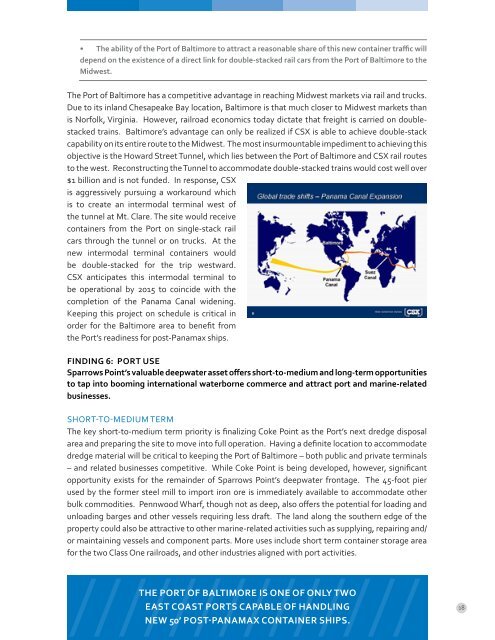COMMON GROUND
You also want an ePaper? Increase the reach of your titles
YUMPU automatically turns print PDFs into web optimized ePapers that Google loves.
• The ability of the Port of Baltimore to attract a reasonable share of this new container traffic will<br />
depend on the existence of a direct link for double-stacked rail cars from the Port of Baltimore to the<br />
Midwest.<br />
The Port of Baltimore has a competitive advantage in reaching Midwest markets via rail and trucks.<br />
Due to its inland Chesapeake Bay location, Baltimore is that much closer to Midwest markets than<br />
is Norfolk, Virginia. However, railroad economics today dictate that freight is carried on doublestacked<br />
trains. Baltimore’s advantage can only be realized if CSX is able to achieve double-stack<br />
capability on its entire route to the Midwest. The most insurmountable impediment to achieving this<br />
objective is the Howard Street Tunnel, which lies between the Port of Baltimore and CSX rail routes<br />
to the west. Reconstructing the Tunnel to accommodate double-stacked trains would cost well over<br />
$1 billion and is not funded. In response, CSX<br />
is aggressively pursuing a workaround which<br />
is to create an intermodal terminal west of<br />
the tunnel at Mt. Clare. The site would receive<br />
containers from the Port on single-stack rail<br />
cars through the tunnel or on trucks. At the<br />
new intermodal terminal containers would<br />
be double-stacked for the trip westward.<br />
CSX anticipates this intermodal terminal to<br />
be operational by 2015 to coincide with the<br />
completion of the Panama Canal widening.<br />
Keeping this project on schedule is critical in<br />
order for the Baltimore area to benefit from<br />
the Port’s readiness for post-Panamax ships.<br />
FINDING 6: PORT USE<br />
Sparrows Point’s valuable deepwater asset offers short-to-medium and long-term opportunities<br />
to tap into booming international waterborne commerce and attract port and marine-related<br />
businesses.<br />
SHORT-TO-MEDIUM TERM<br />
The key short-to-medium term priority is finalizing Coke Point as the Port’s next dredge disposal<br />
area and preparing the site to move into full operation. Having a definite location to accommodate<br />
dredge material will be critical to keeping the Port of Baltimore – both public and private terminals<br />
– and related businesses competitive. While Coke Point is being developed, however, significant<br />
opportunity exists for the remainder of Sparrows Point’s deepwater frontage. The 45-foot pier<br />
used by the former steel mill to import iron ore is immediately available to accommodate other<br />
bulk commodities. Pennwood Wharf, though not as deep, also offers the potential for loading and<br />
unloading barges and other vessels requiring less draft. The land along the southern edge of the<br />
property could also be attractive to other marine-related activities such as supplying, repairing and/<br />
or maintaining vessels and component parts. More uses include short term container storage area<br />
for the two Class One railroads, and other industries aligned with port activities.<br />
//////////////<br />
THE PORT OF BALTIMORE IS ONE OF ONLY TWO<br />
EAST COAST PORTS CAPABLE OF HANDLING<br />
NEW 50’ POST-PANAMAX CONTAINER SHIPS.<br />
18



